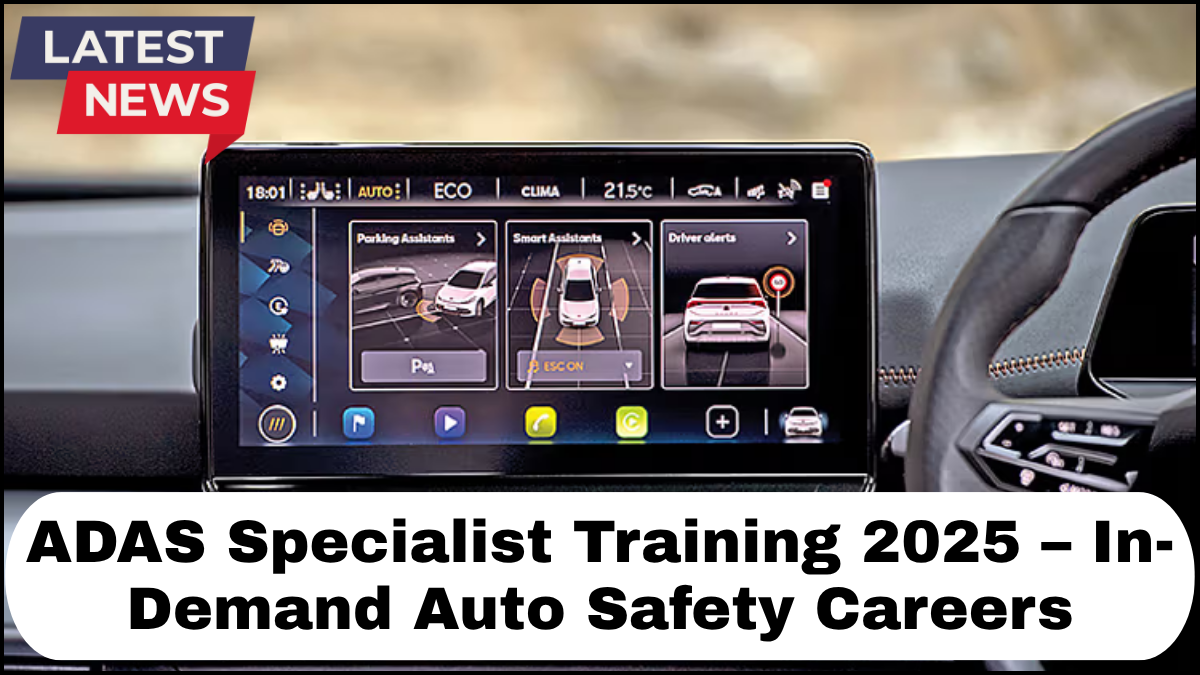The automotive world is shifting rapidly. As vehicles become smarter and more autonomous, the demand for experts who can install, calibrate, and maintain these technologies is surging. At the forefront of this transformation is ADAS Specialist Training 2025, a structured pathway to one of the most promising career fields in the auto industry today: ADAS career roles.

What is ADAS and Why It Matters
ADAS stands for Advanced Driver Assistance Systems. These technologies are built to enhance vehicle safety and improve driving experience. From adaptive cruise control and lane departure warnings to automatic emergency braking and 360-degree cameras, ADAS plays a critical role in reducing collisions and enhancing situational awareness.
As the global push for autonomous and semi-autonomous vehicles intensifies, manufacturers are equipping more vehicles with complex ADAS packages. However, these systems require precise calibration and regular maintenance — a task that only skilled ADAS specialists can perform reliably.
Why Choose ADAS Specialist Training in 2025
The year 2025 marks a pivotal moment for the auto tech industry. Several key factors make ADAS Specialist Training 2025 not just relevant but essential:
-
Explosive Market Growth: According to recent forecasts, the ADAS market is expected to surpass $90 billion by 2030. That’s a massive jump, driven by strict safety regulations and consumer demand for smarter vehicles.
-
Shortage of Qualified Technicians: There is a growing gap between the number of vehicles with ADAS features and the available workforce trained to service them. This shortage creates a golden opportunity for newcomers and seasoned technicians alike.
-
Regulatory Push: Governments around the world are mandating features like forward collision warnings and lane assist in new vehicles. Proper training ensures compliance with these evolving standards.
Core Skills You’ll Gain from ADAS Training
Enrolling in ADAS Specialist Training 2025 equips you with a diverse set of technical and analytical skills. Programs are typically hands-on, combining classroom instruction with live diagnostics and calibration procedures. Key areas of focus include:
► Sensor Calibration Techniques
Training includes how to properly calibrate radar, LiDAR, and camera-based systems after repairs or replacements. Accuracy here is non-negotiable — even minor misalignment can jeopardize safety.
► Diagnostic and Troubleshooting Skills
You’ll learn to use OEM software and scanning tools to identify faults in ADAS components, interpret error codes, and implement the correct fixes.
► Electrical and System Integration
ADAS components are deeply integrated with vehicle electronics. You’ll gain advanced knowledge of circuits, ECU communication protocols, and wiring schematics.
► Real-World Vehicle Simulations
Modern training environments simulate real-life repair conditions. This prepares you to handle in-shop challenges such as poor lighting, alignment rack issues, or limited access to factory calibration targets.
ADAS Career Roles in High Demand
Graduates of ADAS training programs can step into a variety of high-paying, high-growth roles. Some of the most in-demand ADAS career roles include:
-
ADAS Calibration Technician – Specializes in post-collision recalibration of sensors and cameras.
-
Field Service Technician – Travels to auto shops or accident sites to perform mobile calibration services.
-
ADAS Systems Analyst – Works with data collected from vehicle sensors to improve system performance and safety outcomes.
-
Technical Trainer – Educates other technicians in ADAS installation and calibration best practices.
-
OEM Specialist – Works directly with car manufacturers to integrate and troubleshoot ADAS modules during vehicle production.
Who Should Consider ADAS Training?
Whether you’re a seasoned automotive technician looking to future-proof your skill set or a newcomer wanting to break into a high-tech trade, ADAS Specialist Training 2025 offers a clear path. Even professionals in adjacent industries — such as auto glass repair, collision services, or electronics — can benefit from adding ADAS expertise to their resume.
Choosing the Right Training Program
When evaluating an ADAS training program, prioritize those that offer:
-
OEM-certified curriculum
-
Access to the latest diagnostic tools and calibration equipment
-
Instructors with real-world ADAS experience
-
Job placement assistance or industry connections
Look for programs that include live vehicle calibration sessions and exposure to a variety of vehicle makes and models.
Frequently Asked Questions (FAQ)
Q1: How long does it take to complete ADAS Specialist Training in 2025?
Most programs range from a few weeks to a few months, depending on intensity and format. Fast-track bootcamps are also available for experienced technicians.
Q2: Is ADAS certification required by law?
While not always legally required, certification from recognized training providers greatly enhances your job prospects and credibility in the field.
Q3: Can I specialize in ADAS without prior automotive experience?
Yes. Many programs offer entry-level tracks, though having a background in automotive systems or electronics is a strong advantage.
Q4: What’s the average salary of an ADAS specialist?
Entry-level ADAS technicians can earn between $50,000 and $70,000 annually, while seasoned professionals or OEM specialists can exceed $90,000.
Q5: Are there remote or online options for ADAS training?
Some theory portions can be completed online, but hands-on calibration and diagnostics must be done in a physical training environment.
click here to learn more